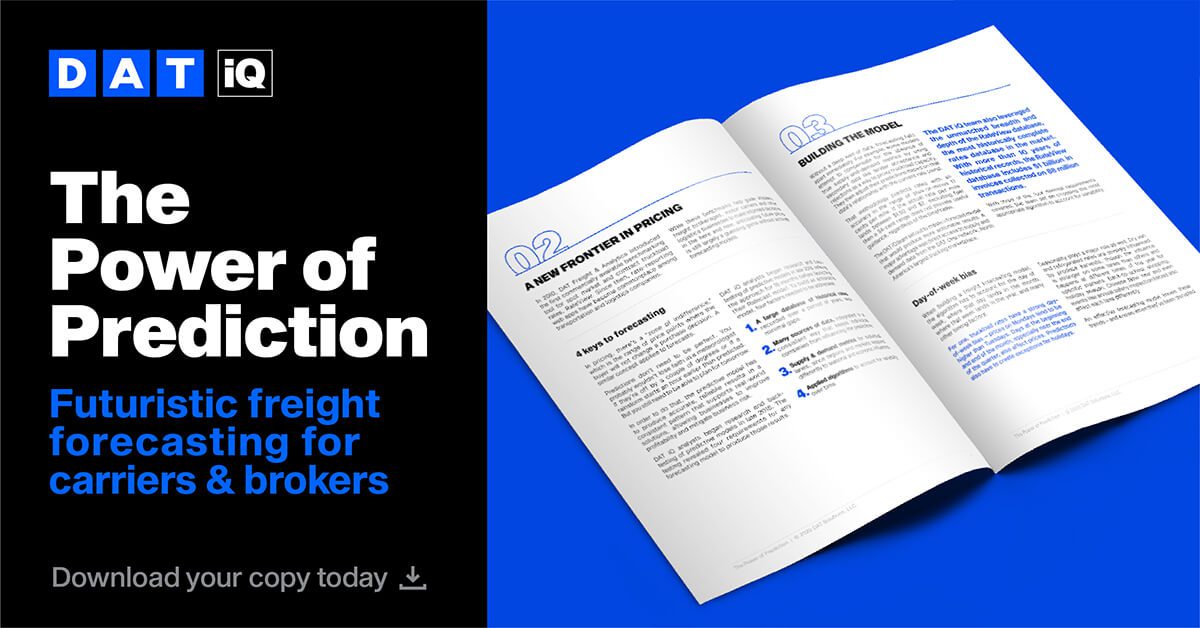Transportation providers make pricing decisions every day to attempt to win loads that will be moving in the coming days, weeks or months. Removing guesswork from the pricing routine has become imperative during the last two years of volatile freight market conditions due to pent-up demand, tight capacity and fractured supply chains.
Freight brokerages and carriers are accustomed to pricing freight based on historical data and operating costs. A number of vendors provide industry rate analytics and benchmarking tools that use historical averages, ranges and trends. Companies use the tools to view rates in different markets and drill down to lane-level details. What transportation providers really need to make profitable decisions is rate forecasts that do more than summarize historical data.
Forecasting rates with greater precision requires going advanced statistical modeling techniques as well as a significant amount of data. Artificial intelligence (AI) and algorithms can be developed and refined to understand complexities and dynamic pricing variables in the freight market.
AI-assisted rate forecasting removes the guesswork. Granted, the predictions are not perfect, but they will enable businesses to make informed decisions and successfully bid on loads, negotiate rates and more profitably execute those loads.
With accurate rate forecasts, freight brokerages can submit prices that enter the high side of the strike zone known as the “zone of indifference.” Within this range, the price will be such that buyers will not change their purchase decisions.
In order to hit the mark, a predictive rate model must produce accurate, reliable results on a consistent basis. Only then can organizations implement process changes to repeatedly improve decision making to raise profitability and lower business risk.
When building such a model, DAT iQ analysts found that in order to consistently produce desired results, the rate forecasting model must meet four requirements.
1. A large database of historical rates recorded over a period of years, with minimal gaps. The model relies on voluminous historical data to accurately forecast spot and contract rates to accurately predict future rates. DAT’s large database of numbers from multiple data sources makes it uniquely qualified to produce reliable forecasting.
2. Many sources of data, integrated in a consistent way. This keeps data from individual companies influencing the predictions. To produce accurate rate forecasts, the data needs to be varied across lanes, industries, shipment types and other attributes. If the data source isn’t varied enough to account for discrepancies or differences in freight pricing, then the forecast will be skewed. AI-enabled forecasting can spot outliers in data and account for significant influencers.
3. Supply and demand metrics for individual lanes, since regions and markets respond differently to seasonal and economic influences. Accounting for the shifts in supply and demand helps increase accuracy in the AI forecasts.
4. Applied algorithms to account for variability over time. Predictive rate models do not use set-it-and-forget-it formulas. The algorithms learn from being tested and validated against real-world market prices. For validation, the Ratecast predictive mode from DAT iQ uses median absolute error. This measures the median absolute percent difference between what the model has previously forecasted the average market rate would be on a given number of days out from the forecasting date and what the market rate turned out to be.
Measuring Ratecast across more than 7 million daily predictions, the model proved to be accurate more than 95 percent of the time.
Be prepared with AI forecasting
There is an old saying, “the best predictor of future behavior is past behavior.” The freight market is complex, but AI can make truckload spot and contract rate forecasting remarkably predictable.
With accurate AI-assisted rate predictions, shippers and freight brokers can budget properly, improve logistical decision-making and build solid carrier relationships. Reach out to DAT for more information about how to use cutting-edge freight analytics tools to make better pricing decisions.


